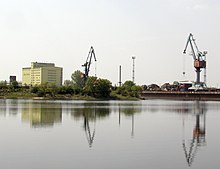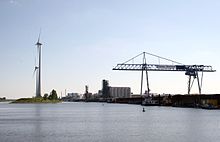Magdeburg harbor
The port of Magdeburg is located in the state capital of Saxony-Anhalt, Magdeburg, and consists of four ports used for cargo handling. The port of Magdeburg is spread over the Magdeburg districts of Alte-Neustadt , Industriehafen and the north industrial area . With its extension of almost 10 km along the Elbe, it is one of the largest and most important inland ports in Germany.
location
With its central location at the meeting point of the Mittelland Canal , Elbe-Havel Canal and Elbe , the Magdeburg waterway intersection , the port offers a good starting point for transshipment traffic. It is located in the catchment area of the seaports of Hamburg and Bremen . It is also directly connected to the A 2 with proximity to the Magdeburg motorway junction ( A 14 ) and has its own port railway with a connection to the railway network at the Magdeburg junction. Magdeburg-Cochstedt Airport is located south of Magdeburg , and thanks to new investments in a 68 hectare industrial and commercial area and two large cargo halls, it can offer cargo air traffic.
history
The first mention of shipping on the Elbe comes from the year 789. Due to the development of steam shipping and the subsequent increase in transport capacities, the handling and storage capacities in Magdeburg were no longer sufficient. After seven years of construction, the trading port was opened in 1893. At that time it gained a reputation as the most important port for handling sugar and salt. The industrial port was built from 1908 to 1911. It got its name from the factories located there. In the years from 1929 to 1932, Magdeburg's largest port, the Canal Harbor, was built. After the completion of the Rothensee ship lift in 1938, he was responsible for traffic coming from the Mittelland Canal.
During the GDR era , the Magdeburg ports were combined in the VEB inland ports Middle Elbe and mainly handled bulk goods.
After the turnaround and the dissolution of the VEBs, Magdeburger Hafen GmbH was founded on March 18, 1992. In order to raise the infrastructure of the ports to the western level, various large investments were made. One of the largest projects was the expansion of the waterway connection from Hanover via Magdeburg to Berlin. Construction of a trough bridge over the Elbe to connect the Mittelland Canal and the Elbe-Havel Canal began in the 1930s, but it was not ended due to the Second World War . This did not happen during the GDR era either. The Magdeburg canal bridge over the Elbe was completed in 2003 with VDE No. 17 . The Rothensee lock, built in 2001 , then replaced the outdated ship lift. As the last port to date, the Hanseatic Port was created in 2008 to enable further settlements on port-relevant areas. Since the Magdeburg low water lock was completed in 2013 and a constant water depth of 4 m was achieved, the port can be approached every day regardless of the remaining water level of the Elbe.
The Greenport climate protection project was launched in 2011 together with the Magdeburg municipal works and the wind turbine manufacturer Enercon . The project includes the acquisition of a hybrid locomotive including an electric charging station operated with renewable energy, the supply of the Hanse Terminal and the inland waterway vessels docked there with electricity from renewable energies and the construction of an electric charging station for small trucks whose energy supplier is a large wind turbine of the type E 126 with an output of 7.5 MW el .
Ports
The port of Magdeburg consists of the four ports:
- Commercial port (conversion to science port )
- Industriehafen with the Industriehafen terminal
- Canal port with the terminals Trennungsdamm and Zweigkanal
- Hanseatic port with the freight center and the Hanse terminal
Facts
Goods of all kinds can be handled in the Magdeburg ports. For bulk , liquid , container or heavy load handling, the various ports have certain systems such as a sugar handling system with bagging, liquid handling systems, several port , mobile and gantry cranes with a load capacity of up to 50 tons or a CT / container terminal with several reach stackers to disposal. The main handling products include grain, sugar, containers, metals, steel scrap and petroleum products.
The ports have a total of 207,500 m² of paved and unpaved storage space and 8,200 m² of covered storage space, with a further 20,000 m² planned. In addition, the Port of Magdeburg has a dangerous goods storage area of 2,800 m² and a heavy-duty area of 1,200 m². The total area of the ports including water is 655 ha with a total bank length of 14 km. In the port area there are over 115 hectares of settlement area for industrial companies. The largest companies in the port include the wind turbine manufacturer Enercon , Dachser GmbH & co. KG , Magdeburger Getreide GmbH, Deutsche Erz- und Metall-Union GmbH (DEUMU), Nordlam GmbH or the Magdeburg-Rothensee waste-to-energy plant .
In 2014, the port operator Magdeburger Hafen GmbH handled goods weighing around 3.5 million tons. In 2005, 3 million tons were handled in the Magdeburg ports. In the container business, throughput rose by around 40% compared to the previous year. The port of Magdeburg is therefore one of the most important inland ports in Germany.
Port railway
Magdeburger Hafen GmbH has a port railway , which is operated as a public railway infrastructure company, and has 3 locomotives, including a V100 hybrid locomotive from Alstom . The track network has a length of 54 kilometers. It also has a dynamic track scale with a weighing range of up to 120 tons. Through the connection to the Magdeburg-Rothensee train station, the port railway is connected to the Magdeburg railway junction and the European railway network. In addition to shunting services in the port area and at Magdeburg-Rothensee station, the port railway also provides wagon inspectors, the parking of freight wagons and traction vehicles, the weighing of freight wagons and workshop services.
In 2014, 1.4 million tons of goods were transported on the Magdeburg port railway, an increase of eight percent compared to the previous year.
particularities
- The first Magdeburg harbor, the winter harbor , is usually no longer counted as part of Magdeburg harbor. Today it is mainly used for pleasure craft. This also applies to other port facilities upstream such as the Sülzehafen .
- There is a listed railway lift bridge in the area of the commercial port . However, it is fixed in a lowered position and can only be used by pedestrians and cyclists.
- In June 2012, as part of the Greenport project with SWM and Enercon , the port railway became the first European inland port to purchase a V100 hybrid locomotive from Alstom. In addition, an E 126 wind turbine was built as part of this project , which with 7.5 MW el was the largest of its kind in the world at the time of completion in February 2011.
- The new low water lock is located at the level of Steinkopfinsel . This lock ensures that the water level in the port basins of the canal port and the Hanseatic port is sufficient for shipping even when the tide is low on the Elbe, so that the port of Magdeburg can be approached from the Mittellandkanal by normally loaded ships even when the tide is low.
- Current plans envisage a separation dam between the western and eastern industrial port and the opening of the dam at the branch canal (canal port). [obsolete] This means that the part of the industrial port that is mainly used would no longer be affected by low water.
- In recent years, the commercial port has lost its importance for shipping. The site is currently being converted into a modern science and museum site under the name Magdeburg Science Harbor. Among other things, the “Institute for Automation and Communication” (ifak) in the think tank, the “Virtual Development and Training Center” (VDTC) of the nearby Fraunhofer Institute (IFF) or the “Development laboratory and test field for location and communication in Transport and Logistics ”of the European Galileo project is located in the Science Harbor.
Web links
Individual evidence
- ^ Project Greenport at the port of Magdeburg
- ^ Handling in Magdeburg is increasing . In: Daily port report of January 30, 2015, p. 4
- ^ Port on the road to success www.volksstimme.de February 8, 2015
- ↑ Magdeburger Hafen shunting with hybrid locomotive ( page no longer available , search in web archives ) Info: The link was automatically marked as defective. Please check the link according to the instructions and then remove this notice.
- ↑ Largest wind turbine in the world
- ↑ Completion of the Magdeburg low water lock www.volksstimme.de August 8, 2014
- ↑ State capital Magdeburg - The Lord Mayor: Reactivation of special port areas in the industrial port through year-round full-ship connection to the Mittelland Canal. June 23, 2016. Retrieved July 21, 2016 .
- ↑ Conversion of the commercial port to the science port www.mz-web.de July 20, 2011
Coordinates: 52 ° 10 ′ 29 " N , 11 ° 40 ′ 33" E





